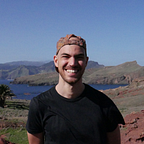To the stars or nothing: a cosmic perspective.
🎬 You can watch this content as a video here.
When you look up at the stars at night, what do you see?
For most of my life I looked up at the stars without thinking too much about them. They were fascinating, surely, but not for more than a captivated glance. I looked at them, but I didn’t really look at them. In a way, I didn’t want to confront their existence, because that meant confronting my own and that of our species.
Acknowledging our place in the universe is acknowledging our vulnerability, and that’s scary. Yet, as I’ve been learning more about our history and about the Universe in which we live in, I had to come to terms with the fact that, in the big scale of the cosmos, we are infinitely small. Almost insignificant, one could say. Still, here we are: conscious, curious and ever more capable.
How long are we going to be around? Will we get to express our full potential? How far can we reach among those stars?
To ponder upon these questions we need to first gain a bit of perspective.
To imagine our future, we must understand how we got here in the first place. Given the magnitude of the task, I’ll humbly stand on the shoulders of the giant Carl Sagan paraphrasing his words from his seminal book Cosmos.
For a long time after the Big Bang there were no galaxies, no planets, no life. Later on the first stars were born, creating — in the alchemy of their nuclear fusion — the building materials of planets and lifeforms. Nearby stars, planets formed. In the process of solidifying and warming, one of them, the Earth, released gases trapped in its core forming the primitive atmosphere and the first oceans. In those oceans, one day quite randomly, a complex cell arose that was able to make a copy of itself.
To better stress this event, before we continue the story, here is how physicist Brian Cox describes it:
“It looks like, somewhere 2 billion years ago in some ocean, the bacteria cell got inside the Archaea, and survived as a symbiotic organism. And somehow, unbelievably, managed to survive and reproduce and replicate in that configuration. That seems to be the origin of all complex multicellular life on Earth. It’s called ‘The fateful encounter hypothesis’ and if that is true, then it’s just a bit of luck. And it happened once. And that’s why we’re here.”
By natural selection, better self-replicating cell arose. Slowly but surely, life had begun. Single-celled plants evolved to synthesize their own food from sunlight, releasing oxygen as a waste product, irreversibly transforming the atmosphere. Many lifeforms died because of it, many others flourished because of it. For the sake of specialization, some organisms grew in complexity. They evolved chemical receptors to taste and smell, eyes and ears to see and hear. They discovered the land to be suitable for life. First fishes, then mices, then apes our ancestors evolved in the hostile environment of the African savannah.
When forced to leave the trees, they found in cooperation the key to survival. Grouped in tribes, they sat by the fire at night, looking for the first time at the starry sky above them. 💫
It’s hard to integrate billions of years of evolution in the daily perspective of our short lives, but if we want to truly honor the past, appreciate the present and value our future we must make an effort to do so.
Since we first started roaming the Earth, we came a long way in our quest for survival: from leveraging stones and fire, to farming the land and domesticating animals, to burning fossil fuels and building cities we created the civilization in which we live today. Against all odds, we have reached a point in our evolution where we have the tools and the knowledge to engineer our own existence. A point where we can imagine the future out of inspiration, rather than desperation.
From the first Eukaryotic cell to the first settlement on Mars, we could continue our journey throughout the Solar System and beyond, planet-hopping one day around the galaxy. The dream is within reach: empowered by international scientific collaboration, we can make it happen.
Yet, we might never do it. If we keep taking this life and planet for granted, we could be the cause of our own extinction, like in the case of nuclear war or environmental damage. If we will destroy ourselves, the Universe wouldn’t care, the planet wouldn’t care, evolution wouldn’t either. The unborn generations of humans would. Well, if they knew.
Some people think that humanity is enjoying a few final laps around the Sun, while others are working hard to reduce the existential risk by making humans a multiplanetary species. As the proverb goes, today we sit in the shade of the trees planted by all the hunters, farmers, and scientists who came before us. What we owe to them we owe to the next generations. The stakes are high: this is the only opportunity for humanity to keep contemplating the stars and, possibly, soon, travel around them.
Hopefully, as Sagan imagined, one day our future descendants, scattered throughout the Milky Way, will look up at the sky to find that pale blue dot where their ancestors came from. As he writes:
“They will marvel at how vulnerable the repository of all our potential once was, how perilous our infancy, how humble our beginnings, how many rivers we had to cross before we found our way.” — Carl Sagan (Pale Blue Dot, 1994)
When you look up at the stars at night, what do you see? 🌌
😍 Loved the article?
Share it with a friend or on social media.
😎 Wanna read more?
Join my monthly newsletter!
